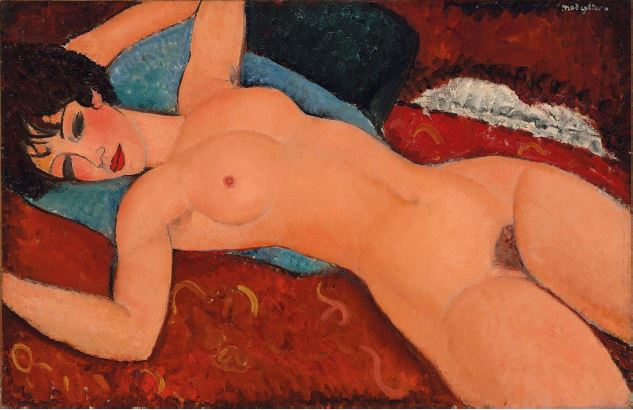
Amedeo Modigliani’s Nu Couché is expected to enter the rarefied $100 million club tonight. There are a number of reasons for high expectations for this stellar work by one of modern art’s top masters, a painting that has been widely reproduced in art historical literature. Arguments can be made that this is his best nude and perhaps his best painting ever. It is pure, quintessential Modigliani: it has rich, unique colors; lush paint handling; and pulsing eroticism. Monday night’s sale might be a once-in-a-generation event.
There is a hierarchy in the Modigliani field in terms of which works are most coveted by collectors and museums alike: first, it’s the nudes, followed by portraits of women, children, and men.
Modigliani clearly had a facility for portraying women with sensuality and tenderness. His images of women make up the bulk of his art. Portraits of children emerged as a major category in his art around the time that his daughter was born. There is a poignancy in these paintings in the majesty and grandeur which he accords his young subjects, most of whom came from humble backgrounds.
By painting nudes—long a traditional subject—Modigliani was tying himself to art history. Modigliani’s nudes were especially shocking, though, because they were so contemporary. The figure he painted could be your neighbor. The frankness of his nudes caused a ruckus at his only lifetime solo exhibition where this painting may have been shown. There are only about 30 Modigliani nudes, less than 10 percent of his oeuvre, and many are already in museums.
Indeed, Modigliani’s output was small. He died young, at age 35, having created approximately 350 paintings. By contrast, Pablo Picasso made thousands of paintings during his 91 years (the exact number of paintings varies widely).
In the Modigliani field, one likes to see that a given painting is included in Ambrogio Ceroni’s respected Catalogue de l’Oeuvre Peint de Modigliani. Not only is this painting featured in Ceroni, but it is on the cover of two editions of his book. That serves as a powerful indication of how highly Ceroni valued the work. Adding further to the painting’s appeal is the fact that it has been in the famous Mattioli collection since 1949.
Modigliani’s market has made up for lost time, having been seriously undervalued for years. Less than 15 years ago, his paintings sold in the $5-10 million range while Picasso, Auguste Renoir and Vincent van Gogh sold for exponentially more. A Modigliani sculpture was offered in 1995 with an estimate of $1-2 million (far below the prices for a work by Constantin Brancusi). It was bought in. A Modigliani sculpture sold recently for $70 million.
The common refrain in the market is that quality works are more and more difficult to find. So when a clear star emerges, there is a feeding frenzy. That will undoubtedly be the case Monday night.